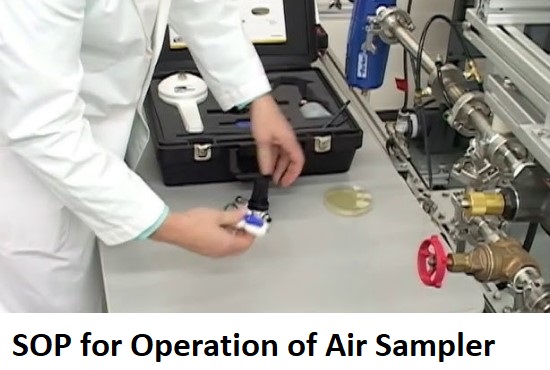
This SOP for Operation of Air Sampler outlines the procedures for the proper operation of the air sampler to ensure accurate and reliable air quality monitoring within the [Your Organization Name] facility.
PURPOSE
To describe the procedure for the operation of the air sampler.
SCOPE
This procedure is applicable for the operation of an air sampler at the microbiological laboratory of QCD and the Manufacturing area. This SOP applies to all personnel responsible for operating the air sampler within the organization.
RESPONSIBILITIES & AUTHORITIES
- It is the responsibility of microbiologist to follow this SOP as it is written
- It is the responsibility of QC manager to review and update this SOP as necessary and to ensure that this SOP is followed in its entirety.
REFERENCES & REQUIREMENTS
- Code of Federal Regulations, July 1, 1990.40 CFR part 160 Good Laboratory Practice Standards.
DEFINITIONS & ABBREVIATIONS
- Air sampler: Air sampler is a device used for sampling the air for testing the microbiological purity of air.
- Agar strips: Agar strips are ready to use strips containing agar media for assessment of microbial and fungal levels in the air.
PROCEDURES
Materials And Equipment’s
- Air sampler,
- Agar strips, Biotest Hycon or equivalent
- Gloves, mask and safety glasses
- Screw driver
- Isopropyl alcohol (70%), Merck or equivalent
- Duster
- Sterile sampling media (appropriate for the targeted contaminants)
- Disinfectant solution
- Timer
- Sample labels
- Logbook for recording sampling details
Pre-Sampling Preparations:
- Ensure that the air sampler is clean and in proper working condition.
- Wear sterile gloves while handling sampling media to prevent contamination.
- Prepare the required number of sterile sampling media and label them with appropriate information, including date, time, location, and sampler ID.
- Disinfect the exterior of the air sampler using an appropriate disinfectant solution.
Setting Up the Air Sampler:
- Place the air sampler at the desired location, ensuring it is stable and won’t be disturbed during sampling.
- Connect the sterile sampling media to the air sampler inlet, following the manufacturer’s instructions.
- Set the air sampler flow rate according to the sampling requirements and contaminant being monitored.
- Calibrate the air sampler if necessary, following the manufacturer’s guidelines.
Safety Considerations
- Wear appropriate gloves, safety glasses and mask during operating.
Disinfection procedure
- Remove the protection envelop of air sampler to gain access to the fan.
- Unscrew the fan and head of air sampler.
- Dip the fan and head of air sampler in 70% ethanol for half an hour.
- After half an hour screw back the fan and head.
- Put on protection envelop back.
Operation
- Switch ON the air sampler by rotating the knob to position “ON”.
- Red light indicates that the air sampler is “ON”.
- Adjust the Slide Control Knobs for desired time of sampling.
- NOTE: Slide Control Knobs are marked with numbers 1, 2, 3 and 4 indicating the time duration e.g. at position “1”, one minute sampling is obtained and soon.
- Remove the protection envelop of air sampler to gain access to the fan.
- Open the wrapper of bio-test agar strips for a few centimeters by pealing back the plastic seal at the rounded side of the wrapper.
- Remove the bio-test agar strip with the coated side facing downwards.
- Insert the bio-test agar strip facing the fan, into the head of air sampler through the open Slit.
- Press the “START” knob.
- Place the air sampler into the section from where the air sample is to be taken.
- When the sampling process is finished, pull out the agar strip from air sampler and place it into its original wrapper.
- Seal the wrapper with slide seals.
- Switch off the air sampler by rotating the knob to position “OFF”.
- After the work performed, disinfect the fan and head of air sampler with 70% ethanol for half an hour as per step 7.
- Wipe the interior surface of the air sampler by using wet duster.
- Record the results in Air Sampler Logbook.
- NOTE: Air sampler is externally calibrated on annual basis or whenever required.
Post-Sampling Procedures:
- After the sampling duration is complete, stop the air sampler.
- Carefully disconnect the sampling media from the air sampler inlet, avoiding contamination.
- Label the sampling media with any additional relevant information, such as the nature of the sample and the purpose of the analysis.
- Seal the sampling media in a sterile container for transportation to the laboratory, following appropriate protocols.
- Record all sampling details in the logbook, including date, time, location, sampler ID, flow rate, and any observations made during sampling.
Safety Precautions:
- Always wear sterile gloves when handling sampling media to prevent contamination.
- Follow appropriate safety protocols and wear necessary personal protective equipment while operating the air sampler.
Precautions
- Do not insert the contaminated strips in the air sampler.
- Be sure to insert coated surface of agar strips facing the fan.
- Always wear sterile gloves when handling sampling media to prevent contamination.
- Follow appropriate safety protocols and wear necessary personal protective equipment while operating the air sampler.
DOCUMENTS (FORMS & ANNEXURE)
- Log book of operation of air sampler.
- All data related to air sampling, including sampling dates, locations, equipment IDs, flow rates, and any deviations from the standard procedure, must be documented in the logbook for future reference and analysis.

